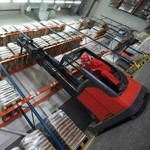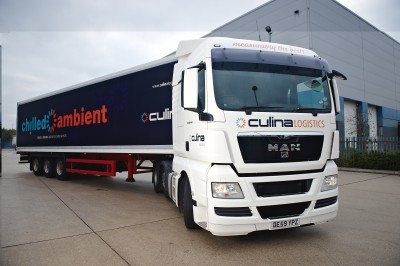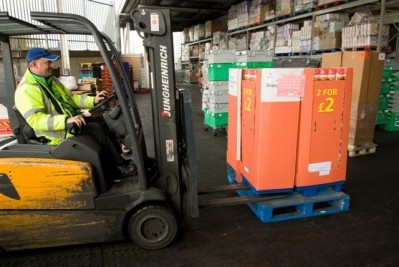Taking the right fork

In a sector where fuel efficiency, ease of use and maintenance, and flexibility are key, FLT suppliers are continuing to come up with fresh ideas, creating vehicles they hope will change the way we think about warehousing and manufacturing operations. Some are going further by creating futuristic designs and capabilities. The latest FLT developments have involved pushing the design 'envelope' to enhance efficiency, safety and user comfort.
But food industry users have questioned the need for so much extra functionality more 'bells and whistles' when what they actually seek are lower costs and greater reliability in use. Brian McDill, solutions and operational director at third-party logistics (3PL) provider Norbert Dentressangle is particularly sceptical about the benefits of many new FLT developments. He is not alone.
Whizzy new forklift
The food supply chain requires systems and equipment that will improve supply chain and transport efficiency rather than whizzy new forklift trucks, claims McDill.
McDill cites the vehicle tracking and telematics; transport management and planning; and proof of delivery systems available from transport management solutions provider Microlise as examples of the sort of technological developments that can make a real step-change in supply chain efficiency.
These systems can have a significant impact on pressing everyday logistics issues that, when implemented, have benefits for both 3PL and customers, he says: from reducing transport costs and carbon dioxide emissions, to improving customer tracking systems and driver safety.
On the hardware side, what he would really like to see developed is specialist equipment to assist with the unloading of goods from trucks at warehouses and regional distribution centres. McDill calls on forklift suppliers to come up with solutions that will simplify the unloading process, making life easier for 3PL and customer.
Samworth Brothers
Nathan Leach, assistant distribution manager at chilled foods company Samworth Brothers, says more rugged FLT designs are needed to keep up with today's warehouse environments. He adds that a reduction in forklift servicing charges would also help to keep down the cost of maintaining vehicles.
Convenience foods manufacturer Greencore shares Samworth's concern over servicing costs. "The biggest issue on forklift trucks is the price of maintenance," says a Greencore spokesman. "The 'up-time' and the performance of the vehicles in the environment is key because these vehicles are costly to maintain," he adds. "Future designs need to last because manufacturers can't work with equipment that requires constant servicing."
However, the Forklift Truck Association (FLTA) argues that such buyer resistance to new FLT developments could prevent the next generation of forklift trucks from ever reaching the market. The FLTA recognises that high prices present a barrier to investing in the latest 'cutting edge' FLT developments, with many potential users putting off buying new trucks until prices fall.
However, the FLTA disputes that FLT manufacturers are developing features that are not required by users in the market. "Most [FLT suppliers] want to be in the vanguard of new developments, but not so far ahead that the market is unwilling or unable to accept and benefit from their products," it says.
Future FLT concepts
New FLT concepts just hitting the market range from hydraulic devices that can tilt and elevate a forklift's cabin to provide the operator with a clear view of the work area to in-built vacuum systems that suck dust from the cabin floor.
Work is also underway by German FLT manufacturer Still to improve flexibility of use, enabling FLTs to be used for a range of warehouse duties something that has been welcomed by end users who see the opportunity to reduce the number of FLTs they use.
Samworth's Leach remarks that flexibility in forklift operation will be a "paramount" requirement in the future. Still's Cubexx concept goes some way to meeting this demand by combining multiple features into one truck, which is able to perform six different jobs.
Another feature in development by Doosan is the use of 'augmented reality systems': a technology that gives the FLT user a wider view of what is happening outside of a vehicle.
The system uses camera sensors on the outside of the vehicle to give the operator a full view of what is happening around him. Images are then projected on a screen within the cabin showing possible hazards around the driver while the truck is carrying a load.
Energy efficiency
Another area where both FLT suppliers and end users are in agreement is in the need for more energy-efficient FLTs. Rechargeable Lithium-ion (Li-on) batteries are now available, which help to reduce carbon dioxide emissions, noise and cost. These now feature on FLTs from a variety of manufacturers, including Still's Cubexx truck and Doosan's futuristic Intelligent Concept Forklift.
However, the FLTA cites the slow uptake of Li-on batteries as a classic example of end users being initially unwilling to pay for the latest technological advances, which come with a higher price tag. "Weaning people away from existing practices can be a slow process," said an FLT spokesman.
More recently, Tesco has placed orders for the latest Jungheinrich forklift, the EJE22Li, which uses a Li-on battery that comes in the form of a briefcase weighing just 14kg. The battery doesn't require an in-house docking bay so it can be recharged at any power source.
"Batteries need to be efficient and interchangeable to keep costs down," remarks Leach. "A battery that is easily rechargeable and replaceable would be ideal in the future." The spokesman for Greencore agrees that more efficient batteries are needed. "Batteries need to have a short charge time and a long running time in the future," he says. "There is a definite need for more efficient trucks."
Improved energy efficiency throughout the logistics and supply chain will become a far more pressing issue, predicts Chris Sturman, chief executive officer of the Food Storage and Distribution Federation.
Sturman argues that energy reduction should be the deciding factor for food manufacturers and 3PLs when acquiring forklift trucks. "The need to maximise the productivity of forklifts must be recognised [by FLT suppliers], while focusing on energy efficiency and operating cost reduction. It is a functional piece of equipment that has to last, despite heavy utilisation in 24- hour operations with possible user abuse in certain environments", says Sturman "At the end of the day, is it still going to deliver in five years' time, at minimal operational, energy, repair and maintenance costs?"
However, because of differences between the specific needs of FLT users in different sectors of the food and drink industry from ambient and chilled, to frozen operations and those of FLT manufacturers, consensus between the two sides on what constitutes the ideal is unlikely.
FLT suppliers are looking to minimise their inventories by standardising on trucks designed for use across an array of industries. And it should not be forgotten that FLT suppliers operate lucrative businesses in maintenance and spare parts supply.
So one thing seems likely: whatever new kit emerges next, price and running costs will remain a contentious issue.















